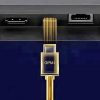By Shelly Palmer (bio), Managing Director, Advanced Media Ventures Group, LLC
It's Time to Buy an HDTV!
Welcome to Shelly Palmer's Technophobe's Guide to HDTV — a very biased, highly opinionated, absolutely partisan instruction manual focused entirely on purchasing something you absolutely don't need.
George Bernhard Shaw once said, "Every profession is a conspiracy against the laity." And, retail television salespeople (most of whom also sell toaster ovens) have the added bonus of having to deal with non-standardized manufacturer's specifications. If they sound like they are speaking in tongues, it's because they are!
Now, you are about to spend somewhere between $600 and $25,000. So, you owe it to yourself to learn some terms-of-art. I have put a short vocabulary list at the end of this piece. I promise if you take a minute or two to read it, you will know more about HDTV and the related technologies than any salesperson you are likely to encounter. If you don't read it, and you don't already speak the language of digital television, this article is not going to make any sense at all!
How Big?
No matter what anyone else tells you, size matters! Remember, 95 percent of the programming you are going to watch for the foreseeable future was not shot for, nor will it be presented in the aspect ratio of HDTV which is 16:9 (16 units wide and 9 units high). It will either be 4:3 standard definition television format or 2.35:1 which is motion picture format.
This means that you are going to see two vertical bars in black or gray surrounding shows that are shot in SD (480p or 480i) and you are going to see a letter box or black bars above and below DVDs and wide-screen formatted movies. No, you can't really stretch the 4:3 or 2.35:1 pictures to fit the 16:9 screen you just paid a zillion dollars for. So, you must compensate for the letterbox (vertical or horizontal) by buying a bigger HDTV set. Flat screen or tube, you need the biggest set you can fit in your room because watching an SDTV news program on your new 42" flat screen (16:9, 480p) will be like seeing the show on a 30-32" tube set (4:3, NTSC). You lose approximately 25% of the viewing area.
Retail Reality
All sets of similar prices are of similar quality. This may sound obvious, but it will not look obvious when you get to the store. A 42" set for $1,200 is going to be lower quality than a $1,200 37" set, right? Think again. All $1,200 sets are the same. All $4,000 sets are the same. All $10,000 sets are the same. There is way too much downward price pressure for this not to be true. You can happily buy bigger for cheaper – you will not get hurt.
What to buy
32" sets are about $600 at Costco and Buy.com. They come with free shipping and I would absolutely buy the extended warrantees. These are perfect gifts for the kids — video games will look spectacular on these units. If you have a small apartment or a small viewing room, this is a good choice.
37" for your 12' to 14' bedroom, it is big enough. LG and Samsung make great ones, but the best buy at the moment is from Viewsonic which you can get a Buy.com.
42" small living room. I like Viewsonic, LG and for budget conscious, the new Vizio (Wal*Mart and Costco) is a good choice.
50" and up. Samsung or Sony are expensive, LG is a good choice. You're talking real money now, so there are some aesthetics involved. Think about what you really need. If you can buy an LCoS, LCD projection, DLP or other less expensive technology you will save money.
- CRT (Cathode Ray Tube) Yes, they make HDTV sets with tubes. And, believe it or not, they will give you the best picture quality. They are just very, very big.
- LCoS (Liquid Crystal on Silicon) a projection technology that looks very good.
- DLP (Digital Light Processing) a projection technology from Texas Instruments that looks very good.
- LCD projection – fine for most applications.
- LCD – under 42" this is the way to go. Over 50" bring your checkbook.
- Plasma – over 50" it's the best picture quality, with some trade-offs – you'll be happy.
What's best?
Dumb question. If you have $2,000 to spend, buy what you can afford. If you have $4,000 to spend, same answer. If you have $25,000 to spend, give it to me and I'll buy you a $6,000 set and keep the difference as my fee.
Where to buy
It is important to remember that if you have more money than time, you should NOT shop at the big box stores for this kind of equipment. Pay a little extra and make your purchase from a reputable dealer or major chain that can offer service, installation, repair, exchange, etc. It's easy to get the lowest price and end up paying lots more for returns or waiting months for manufacturers to repair or replace defective units. If they are not born dead, most units will die within the first 10 days of use. Leave this set on as much as possible and power cycle it often. If it lives more than 10 days, it will last for years. Buy.com is a favorite of mine, but if you don't know exactly what you are buying and why, your local Best Buy or Circuit City is a very good choice.
Extended Warrantees
Yes. On site, if available.
What about audio
Some sets come with speakers built in. This may be fine for you. It's personal choice. Most people who purchase sets over 42" will want to install a Dolby 5.1 or 7.1 compatible home theater system. Speaker selection is truly in the ears of the beholder. If you can't hear the difference between a $500 and $5,000 set of speakers, buy the cheaper system. For ultimate simplicity, consider the complete offerings from Bose. These systems are MAP priced, so they cost the same from every authorized dealer. You can save a few dollars by contacting one of their factory outlet stores. There's a good one in Manchester, VT and they will ship systems via UPS.
An important note about digital audio
Digital Audio Outputs (like AES, SPDIF, Coaxial or Optical) on your set-top box or Digital Television Receiver (HDTV) are NOT controllable from the remote control that comes with your cable box. The reason is too technical for this article, but the key take-away is that if you decide to use the digital audio output of your cable box, you will need a universal remote control (that you must configure) to work with your television and your home theater audio system. However, you will get excellent quality audio from the analog audio outputs of your cable box and/or your television receiver and they WILL be controllable from the remote that comes with your cable set-top box. Yes, lower tech — less to brag about, but much, much simpler for all involved. And, most importantly, no perceptible difference in sonic quality.
Get the right Set-top Box
Call your cable or satellite provider and tell them you just purchased an HDTV television set and have them bring you the appropriate set-top box. You can't see HDTV pictures without an HDTV set-top box. If you use an antenna, you will need to purchase a new one that is appropriate for your location and installation needs.
Get the right Cables
You will either need an HDMI connector (Expensive, highly restrictive and not supported by most cable operators) or a DVI connector (less expensive, video only and not supported by most cable operators) or some component video cables (my choice, if supported by your system) depending on the set you purchased. Your cable or satellite provider can tell you what output sockets are included in their set-top box — you will need to know what input sockets are available on your HDTV. Most likely the installer will not have the appropriate cables. You can get them where you purchase your set or you can go online and get them from cablestogo.com — be careful — cables are expensive and you should buy the absolute best quality you can afford. Yes, cables make a difference.
HD DVD or Blue Ray
Neither. Don't even think about buying a high definition DVD player this year. You can get a very nice SD DVD player at Wal*Mart for about $40. It will play every format of standard definition DVD and CD you own or are likely to own for the next two to three years.
Summary
My favorite piece of research from Scientific Atlanta is that 56 percent of the HDTV sets in America are not hooked up properly and the owners do not know that they are not seeing an HDTV picture. 23 percent of the people think that they are getting a better picture anyway (trust me, they're not) and 26 percent believe that when a show says that it is brought to you in HD that they are automatically seeing an HD picture (trust me, they really are not). Do you need an HDTV set this holiday season? Absolutely not. 99.999 percent of all programming is available in SD and will be for the next 10 or more years. In fact, you may seriously hate watching SD pictures on your new flat screen, so make sure you see some good old-fashioned cable pictures on your set before you take the plunge.
On the other hand, HDTV sets have never been cheaper and they look great. Go out and buy one, hook it up correctly and join the party. You'll be glad you did.
Vocabulary List:
NTSC – Most people think it stands for Never The Same Color Twice, but it actually stands for "National Television Systems Committee" and the name of the current analog transmission standard used in the US, which the committee created in 1953.
ATSC – Advanced Television Systems Committee, the government-appointed body in charge of defining the standards for the new digital television system. It is also the name of the new American digital TV standard.
DTV – Digital Television. Please note, all digital television is not HD.
HDTV – High Definition Television. An image with 720 progressive or 1080 interlaced active (top to bottom) scan lines. 1280:720p and 1920:1080i are typically accepted as high-definition scan rates. HDTV Formats include:
480p – Progressive Scan 852 x 480 (sometimes called EDTV) 4:3 television
720p – Progressive Scan 1280 x 720 – some people say it looks smoother for action shots.
1080i – Interlaced 1920 x 1080 – some people say it looks better for scenic shots.
1080p – Progressive Scan 1920 x 1080 – mythical format that you don't need to think about.
SDTV – Standard Definition Television. See NTSC above.
EDTV – Erectile Dysfunctional Television — oh, wait, no … it stands for Enhanced Definition Television — which, by the way does not actually exist so do not even think about buying a tuner or monitor that calls itself EDTV.
DVI – Digital Visual Interface. Connection standard developed by Intel for connecting computers to digital monitors such as flat panels and DLP projectors. A consumer electronics version, not necessarily compatible with the PC version, is used as a connection standard for HDTV tuners and displays. Transmits an uncompressed digital signal to the display. The latter version uses HDCP copy protection to prevent unauthorized copying. See also HDMI.
HDMI – HDTV connection format using a DVI interface that transfers uncompressed digital video with HDCP copy protection and multi-channel audio.
Component – A signal that's recorded or transmitted in its separate components. Typically refers to Y/Pb/Pr, which consists of three 75-ohm channels: one for luminance information, and two for color. Compared with an S-video signal, a Y/Pb/Pr signal carries more color detail. HDTV, DVD, and DBS are component video sources, though most DBS material is transcoded to component from composite signals.
Composite – A signal that contains both chrominance and luminance on the same 75-ohm cable. Used in nearly all consumer video devices. Chrominance is carried in a 3.58-mHz sideband and filtered out by the TV's notch or comb filter.
S-Video – (aka Y/C) abbreviation for luminance/ chrominance signal. Color and detail signals are kept separate, thus preventing composite video artifacts. Cable uses four-pin connector. Used with S-VHS VCRs, DVD players, Hi-8, and DBS receivers.
VGA – acronym for the Video Graphics Array display mode. VGA computer monitors have a resolution of at least 640 X 480 pixels.
SPDIF – Sony/Philips Digital Interface. SPDIF is a digital interface designed to enable digital equipment to transfer digital information with minimal loss.
TV Receiver – combination of a television monitor and television tuner in one device.
TV Tuner – analog or digital device used to tune in television channels.
Monitor – a display only. Good if you are using a cable or satellite set-top box to receive signals.
BNC – Bayonet Neill-Concelman. A cable connector used extensively in television and named for its inventor.
XLR – A very robust, three-pin locking connector widely used in professional audio; also called a Cannon connector after one of its most prominent original manufacturers. In analog applications, particularly in some high-end consumer audio equipment, XLR connectors are used with balanced lines for optimal interference rejection. The pins in an XLR connector usually "point" in the direction of signal flow.
RCA – An RCA jack, also referred to as a phono connector or CINCH/AV connector, is a type of electrical connector which is commonly used in the audio/video market. The name "RCA" derives from the Radio Corporation of America.
About the Author: Shelly Palmer is Managing Director of Advanced Media Ventures Group LLC and the author of Television Disrupted: The Transition from Network to Networked TV (2006, Focal Press). Shelly is also the 1st vice president of the National Academy of Television Arts & Sciences, NY and Chairman of the Advanced Media Committee of the Emmy Awards. You can read Shelly's blog at http://www.emmyadvancedmedia.com. Shelly can be reached at shelly@palmer.net





























